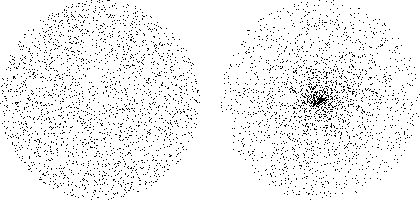Oolite JavaScript Reference: Vector3D
Prototype: Object
Subtypes: none
The Vector class represents a geometrical vector in three-dimensional space, in cartesian representation. It is used to represent positions, headings and velocities. Explaining vector geometry is beyond the scope of this document, but there are numerous tutorials on the web.
Vector Expressions
All Oolite-provided functions which take a vector as an argument may instead be passed an Entity instead, in which case the entity’s position is used. In specifications, this is represented by arguments named vectorOrEntity.
Additionally, most Vector methods may be passed three numbers, or an array of three numbers, instead of a vector. In specifications, this is represented by arguments named vectorExpression. For example, if a and b are vectors whose values are (0, 1, 0) and (1, 0, 0) respectively, the following are equivalent:
var c = a.add(b); var d = a.add(1, 0, 0); var e = a.add([1, 0, 0]); // c, d and e are now all (1, 1, 0).
Properties
x
x : Number (read/write)
The x co-ordinate of the vector.
y
y : Number (read/write)
The y co-ordinate of the vector.
z
z : Number (read/write)
The z co-ordinate of the vector.
Methods
Constructor
new Vector([value : vectorExpression]) : Vector
Create a new vector with the specified value. If no value is provided, the vector is initialized to (0, 0, 0).
add
function add(v : vectorExpression) : Vector
Returns the vector sum of the target and v.
See Also: subtract()
angleTo
function angleTo(v : vectorExpression) : Number
Returns the angle (in radians) between the target and vectorExpression.
v.angleTo(u) is equivalent to Math.acos(v.direction().dot(u.direction())).
cross
function cross(v : vectorExpression) : Vector
Returns the cross product of the target and vectorExpression.
See Also: dot()
direction
function direction() : Vector
Returns the unit vector with the same direction as the target.
v.direction() is equivalent to v.multiply(1 / v.magnitude()).
See Also: magnitude()
distanceTo
function distanceTo(v : vectorExpression) : Number
Returns the distance between the target and v.
u.distanceTo(v) is equivalent to u.subtract(v).magnitude().
See Also: squaredDistanceTo()
dot
function dot(v : vectorExpression) : Number
Returns the dot product of the target and v.
See Also: cross()
magnitude
function magnitude() : Number
Returns the magnitude (or length) of the vector.
See Also: squaredMagnitude(), direction()
multiply
function multiply(f : Number) : Vector
Returns the product of the target and f. This has the effect of scaling the vector by the factor f.
rotateBy
function rotateBy(q : quaternionExpression) : Vector
Apply the rotation specified by q to the target.
rotationTo
function rotationTo(v : vectorExpression [, maxArc : Number]) : Quaternion
Returns a quaternion corresponding to a rotation from the target to v. The optional parameter maxArc specifies a maximum rotation angle; if the angle between the target and v is greater than maxArc radians, a rotation of maxArc radians towards vectorExpression is generated instead.
subtract
function subtract(v : vectorExpression) : Vector
Returns the vector difference between the target and v.
See Also: add()
squaredDistanceTo
function squaredDistanceTo(v: vectorExpression) : Number
Returns the square of the distance between the target and v.
u.squaredDistanceTo(v) is equivalent to u.distanceTo(v) * u.distanceTo(v), or u.subtract(v).squaredMagnitude().
squaredMagnitude
function squaredMagnitude() : Number
Returns the square of the magnitude of the vector.
v.squaredMagnitude() is equivalent to v.magnitude() * v.magnitude().
toArray
This method was added in Oolite test release 1.70.
function toArray() : Array
Returns an array of the vector’s components, in the order [x, y, z]. v.toArray() is equivalent to [v.x, v.y, v.z].
tripleProduct
function tripleProduct(v : vectorExpression, w : vectorExpression) : Number
Returns the triple product of the target, v and w.
u.tripleProduct(v, w) is equivalent to u.dot(v.cross(w)).
Static methods
interpolate
This method was added in Oolite test release 1.70.
function interpolate(u : vectorExpression, v : vectorExpression, where : Number) : Vector
Returns a point on the line between u and v. If where is 0, the result is u. If where is 1, the result is v. If where is 0.5, the result is half way between u and v. Values of where outside the range [0, 1] are valid; for instance, Vector.interpolate(u, v, -1) returns a point as far from u as v is, but in the opposite direction.
Vector.interpolate(u, v, where) is equivalent to u.add(v.subtract(u).multiply(where)), or u.multiply(1 - where).add(v. multiply(where)).
random
function random([maxLength : Number]) : Vector
Returns a vector of random length up to maxLength, in a random direction. If maxLength is not specified (or not a number), 1.0 is used. These vectors are uniformly distributed within the unit sphere, which has the effect that longer vectors are more common than shorter ones. Use Vector.randomDirectionAndLength() if an even length distribution is desired.
In the following image, the cloud on the left was made with the 2D equivalent of random(), and the image on the right was made with the 2D equivalentd of randomDirectionAndLength().
See Also: randomDirection(), randomDirectionAndLength()
randomDirection
function randomDirection([scale : Number]) : Vector
Returns a vector of length scale, in a random direction. If scale is not specified (or not a number), 1.0 is used.
See Also: random(), randomDirectionAndLength()
randomDirectionAndLength
function randomDirectionAndLength([maxLength : Number]) : Vector
Returns a vector of random length up to maxLength, in a random direction. If maxLength is not specified (or not a number), 1.0 is used. These vectors have a uniform distribution of magnitude (all lengths are equally likely), but cluster towards the origin. Use Vector.random() if an even spacial distribution is desired.
See Also: random(), randomDirection()